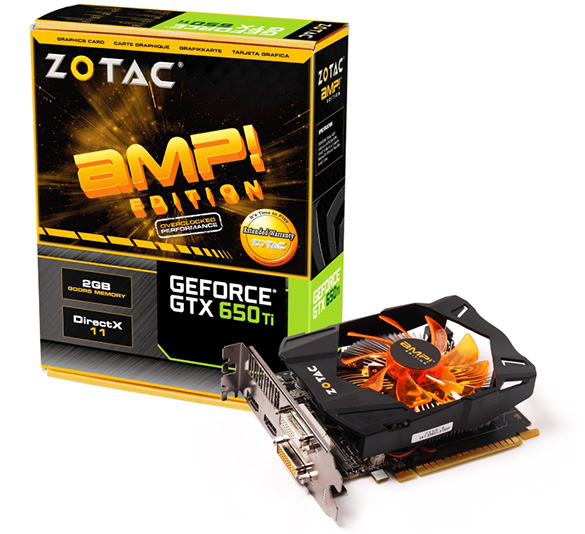NVIDIA GeForce GTX 650 Ti Round-Up: EVGA, ZOTAC, GB
GeForce GTX 650 Ti Cards: ZOTAC, Gigabyte, EVGA
For the purposes of this article, in addition to the stock reference card pictured on the previous page, we got our hands on a trio of custom GeForce GTX 650 Ti cards from a few of NVIDIA’s key partners, namely EVGA, ZOTAC, and Gigabyte.

ZOTAC GeForce GTX 650 Ti AMP! Edition
First up, we have the ZOTAC GeForce GTX 650 Ti AMP! Edition. Like all of the other cards you’ll see here, the ZOTAC GeForce GTX 650 Ti AMP! Edition sports a short PCB, which makes the card appear stubby and relatively small by modern graphics card standards.
Although the ZOTAC GeForce GTX 650 Ti AMP! Edition utilizes a PCB similar in size to NVIDIA’s reference design, its cooler is somewhat different. The ZOTAC GeForce GTX 650Ti AMP! Edition has a compact array of heatsink fins that sit just above the card’s GPU, which are slightly taller than the fins on the reference design. The cooling fan is also somewhat larger on ZOTAC’s offering. The output configuration on ZOTAC’s card (and the rest of the 650 Ti’s pictured here) consist of a pair of DVI outputs and a single mini-HDMI.
Like the other cards featured on this page, ZOTAC has done some factory overclocking with the AMP! Edition too. The ZOTAC GeForce GTX 650 Ti AMP! Edition’s GPU frequency is 1033MHz and its 2GB of GDDR5 memory clocks in at 1550MHz. With those frequencies, the ZOTAC GeForce GTX 660 Ti AMP! Edition should perform best in games that are more memory bandwidth bound, since its memory is clocked higher than the rest.
Included with the ZOTAC GeForce GTX 660 AMP! Edition, we found a user’s manual and quick installation guide, a driver utility disc, a ZOTAC case badge, a peripheral to 6-pin adapter and a DVI to VGA adapter.

Gigabyte GeForce GTX 650 Ti OC Version with Windforce Cooling
Next up we have the Gigabyte GeForce GTX 650 Ti OC Version with Windforce cooling. Although Gigabyte’s card is also overclocked, the real attraction here is the Windforce cooler. Underneath a pair of oversized fans sits an array of aluminum heatsink fins, linked to a copper base via multiple 6mm, copper heat-pipes. The cooler’s dual fans blows air directly onto the heatsinks, where some is diverted into the case and some exhausted outside through the vents in the case bracket. The base of the cooler is shaped in such a way that it reportedly helps minimize turbulence and better direct airflow through the fins. As you’ll see a little later, the Windforce cooler also does an excellent job of keeping temperatures in check, and it’s nice and quiet too. It better perform well, considering it's twice as long as the coolers used on the other cards.
The Gigabyte GeForce GTX 650 Ti OC with Windforce cooler ships with its 2GB of memory clocked at the same 54008MHz (effective data rate) of reference cards, but with a base GPU clock of 1033MHz. Outputs on the card are the same as the reference version as well (2x dual DVI, 1 x mini-HDMI), and Gigabyte’s offering requires the same single 6-pin supplemental power connector of the stock GTX 650 Ti card as well.
Included with the Gigabyte GeForce GTX 650 Ti OC with Windforce cooler were a quick installation guide, driver / utility CD, and a power adapter.
EVGA took a similar approach with their GeForce GTX 650 Ti SSC that ZOTAC took with their AMP! Edition card; both use a cooler with fins that are about twice as all as NVIDIA’s reference design, and both use larger fans and have the same output configuration. EVGA, however, has incorporated a few customizations all their own. The EVGA GeForce GTX 650 Ti SSC sports a custom fan shroud with a carbon-fiber look, and its GPU clock has been increased. Whereas stock GeForce GTX 650 Ti cards have a base GPU clock of 928MHz, the EVGA GeForce GTX 650 Ti SSC is clocked at 1072MHz—the highest of the bunch. EVGA’s card does not have higher clocked memory than reference models, however. The frame buffers on both run at 1350MHz (5400MHz effective).
Other than its clocks, the EVGA GeForce GTX 650 Ti SSC’s features and specifications are similar to the reference design. This particular card has 2GB of GDDR5 RAM and its outputs consist of the same dual DVI connectors and single mini-HDMI. Like the other cards, the EVGA GeForce GTX 650 Ti SSC only requires one 6-pin supplemental power connectors as well.
EVGA’s bundle with the GeForce GTX 660 Ti SC includes a case badge, a quick installation guide and a driver / utility disc, which includes a copy of EVGA’s excellent Precision X overclocking / monitoring utility. In addition, a dual-peripheral to 6-pin power adapter and a DVI to VGA adapter are included as well.







